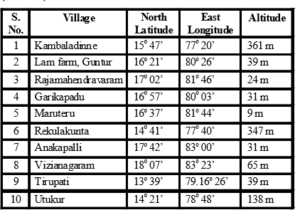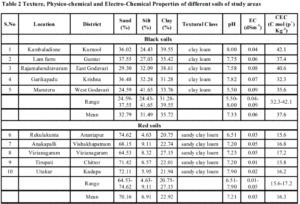SOILTEXTURALIDENTIFICATIONAND PHYSICO-CHEMICALPROPERTIES OFSOME BLACKAND RED SOILS OFANDHRAPRADESH.
0 Views
K NAGARAJU, V MUNASWAMY*, T N V K V PRASAD, Y REDDI RAMU
Department of Soil Science and Agricultural Chemistry, S.V.Agricultural College,ANGRAU, Tirupati – 517502, Chittoor Dt., Andhra Pradesh, India
ABSTRACT
The soil samples collected from different districts of Andhra Pradesh were analyzed in the laboratory for physical, physico-chemical, electro-chemical properties. Five samples of black soils were collected from Kurnool, East Godavari, West Godavari, Krishna and Guntur districts and five soil samples of red soils from Anantapur, Kadapa, Chittoor, Vizianagaram and Visakhapatnam districts Andhra Pradesh. Clay particles from these soil samples were extracted using the International Pipette method. The texture of black soils in the study area ranged from clay loam to sandy clay loam whereas the textures of red soils were sandy clay loam. The black soils in the study area were acidic to slightly alkaline (5.5 to 8.0) in reaction and the red soils were neutral to slightly alkaline (6.51 to 7.9) in reaction. The black and red soils were non saline in nature. The cation exchange capacity of black soils in the study area ranged from 32.3 to 42.1 cmol (p+) kg-1 soil with a mean value of 37.6 cmol (p+) kg-1 soil, while in red soils it ranged from 15.6 to 17.2 cmol (p+) kg-1 soil with a mean value of 16.32 cmol (p+) kg-1 soil.
KEYWORDS:
Texture, Sandy clay loam, Clay loam
INTRODUCTION
Particle size analysis is the measurement of the proportion of various sizes of primary soil particles as determined usually either by sieves of various mesh size or by their rates of settling in water. The proportions are usually represented by the relative weights of particles within stated size classes. There is no general ‘best’ method of doing particle-size analysis. The variation in soil texture might be due to variation in topographic position, nature of Parent material, in situ weathering, translocation of clay and age of the soils.
The present investigation was carried out to study particle size distribution, physical, physio-chemical, electro-chemical properties of black and red of Andhra Pradesh”. For this, ten surface soil samples (0-20 cm) were collected in different districts of Andhra Pradesh covering black and red soils
MATERIALAND METHODS
The topographic details of villages from where the soil samples were collected is outlined in the following table (Table 1)

Samples were collected from top 0-20 cm layer of soil. All the samples were analysed for pH, EC, as per the standard procedures (Jockson, 1973). The cation exchange capacity (CEC) of the soil samples was determined in 1
N sodium acetate (pH 8.2) as described by Bower et al. (1952) and expressed as cmol (p+) kg-1 soil. Clay in the soil samples collected from different locations was separated by following the procedure outlined by Jackson (1973).
RESULTSAND DISCUSSION
Soil pH, EC and Cation Exchange capacity:
The soil reaction in the soils of study area varied from acidic to slightly alkaline. The pH values ranged from 5.50 to 8.00 with a mean value of 7.33 in the black soils (Table 2). The highest pH value of 8.00 was recorded in Kambaladinne village of Kurnool district while the lowest pH value of 5.50 was registered in Maruteru mandal of West Godavari district. In red soils of study area the pH values ranged from 6.51 to 7.90 with a mean value of 7.21. The highest pH value of 7.90 was recorded in Utukur village of Kadapa district while the lowest pH value of 6.51 was recorded in Rekulakunta village of Anantapur district. Similar findings were reported by Ashokkumar and Prasad (2010), Vijayakumar and Haroon (2013), Verma et al. (2014).
The soils of study area were non-saline. The EC values of black soils ranged from 0.04 to 0.09 dSm-1 with a mean value of 0.06 dSm-1. The highest value of 0.09 dSm-1 was recorded in Maruteru village of West Godavari district whereas the lowest value of 0.04 dSm-1 was noticed in Kambaladinne village of Kurnool district. The values of red soils ranged from 0.01 to 0.05 dSm-1 with a mean value of 0.03 dSm-1. The highest value of 0.05 dSm-1 was recorded in Anakapalli village of Visakhapatnam district and Vizianagaram whereas the lowest value of 0.01 dSm-
1 was noticed in Tirupati mandal of Chittoor district. Similar EC values were reported by Ashokkumar and Prasad (2010) in sugarcane growing soils of Ahmadnagar district of Maharashtra.
The CEC of black soils viz., Kambaladinne, Lam farm, Rajamahendravaram, Garikapadu, Maruteru, were 42.1, 37.4, 40.6, 32.3 and 35.6 cmol (p+) kg-1 soil respec-tively (Table 2). The CEC values of study area varied from 32.3 to 42.1 cmol (p+) kg-1 soil with a mean value of 37.6 cmol (p+) kg-1 in black soils. The highest value of 42.1 cmol (p+) kg-1 soil was noticed in the Kambaladinne village of Kurnool district and the lowest value of 32.3 cmol (p+) kg-1 soil was observed in Garikapadu village of Krishna district. The CEC values (Table 2) of red soils viz., Rekulakunta, Anakapalli, Vizianagaram, Tirupati, Utukur, were 15.6, 16.8, 17.2, 15.8 and 16.2 cmol (p+) kg-1 soil respectively. The CEC values varied from 15.6 to 17.2 cmol (p+) kg-1 soil with a mean value of 16.32 cmol (p+) kg-1 soil. The highest value of 17.2 cmol (p+) kg-
1 soil was noticed in the Vizianagaram district and thelowest value of 15.6 cmol (p+) kg-1 soil was observed in Rekulakunta village of Anantapur. Similar results were also reported by Thangasamy et al. (2005) in Chittoor Dt. Of Andhra Pradeshand Sitanggang et al. (2006) in watershed area of Shikohpur, Gurgaon district, Haryana
Particle size distribution:
The Particle size distribution in the study area ranged from clay loam to sandy clay loam. The particle viz., sand, silt and clay contents in the black soils ranged from 24.59 to 37.55, 24.43 to 41.65 and 31.28 to 39.55 per cent respectively (Table 2). The mean sand, silt and clay contents in the above soils were 32.79, 31.49 and 35.72 per cent respectively. The highest clay of 39.55 per cent was recorded in Kambaladinne village of Kurnool district whereas the lowest clay of 31.28 per cent was registered in Garikapadu village of Krishna district. The particle viz., sand, silt and clay contents in the red soils ranged from 64.53 to 74.62, 4.63 to 9.11 and 20.75 to 27.15 per cent respectively (Table 2). The mean sand, silt and clay contents in the above soils were 70.16, 6.91 and 22.92 per cent respectively. The highest clay of 27.15 per cent was recorded in Vizianagaram district whereas the lowest clay of 20.75 per cent was registered in Rekulakunta village of Anantapur district. The variation in soil texture in different study areas were reported by Venkatesu et al. (2002), Rao et al. (2008) and Ramalakshmi et al. (2016).
LITERATURE CITED
- Ashokkumar, H.P and Prasad, J. 2010. Some typical sugarcane growing soils of Ahmadnagar district of Maharashtra. Their characterization, classification and nutritional status of soils and plants. Journal of the Indian Society of Soil Science. 58(3): 257-266.Bower, C.A., Reitemeier, R.F and Fireman, M. 1952. Exchangeable cations analysis of saline and alkali soils. Soil Science. 73: 251-261.
- Jackson, M.L. 1973. Soil Chemical Analysis. Prentice Hall of India Pvt. Ltd., New Delhi, India. pp. 1-498.
Ramalakshmi, S., Sreelatha, T., Veerabhadrarao, K. and Venugopalarao, N. 2016. Effect of sugarcane monocropping on soil physical and chemical properties in texturally varied soils. Agric.Sci. Digest. 36 (2): 155-159.
Rao, A.P.V.P., Naidu, M.V.S., Ramavatharam, N and Rao, G.R. 2008. Characterization, classification and evaluation of different landforms in Ramchandrapuram mandal of Chittoor district in Andhra Pradesh for sustainable land use planning. Journal of the Indian Society of Soil Science. 56(1): 23–33. -
Sitanggang, M., Rao, Y.S., Ahmed, N and Mahapatra, S.K. 2006. Characterisation and classification of soils in the watershed area of Shikohpur, Gurgaon district, Haryana. Journal of the Indian Society of Soil Science. 54: 106–110.
Thangasamy, A., Naidu, M.V.S., Ramavatharam, N and Reddy, C.R. 2005. Characterization, classification and evaluation of soil resources in Sivagiri microwatershed of Chittoor district in Andhra Pradesh for sustainable land use planning. Journal of the Indian Society of Soil Science. 53: 11–21. -
Verma, R.R., Srivastava, T.K and Singh, K.P. 2014. Soil macro and micro nutrient status in sugarcane growing soils of Haridwar district, Uttarakhand (India). Indian Journal of Sugarcane Technology. 29(2): 72-76.
Venkatesu, T., Venkaiah, K and Naidu, M.V.S. 2002. Depth wise distribution of nutrients in groundnut growing soils of Nellore district in Andhra Pradesh. Journal of oilseed Research. 19(2): 185-189.

- Bio-Formulations for Plant Growth-Promoting Streptomyces SP.
- Brand Preference of Farmers for Maize Seed
- Issues That Consumer Experience Towards Online Food Delivery (Ofd) Services in Tirupati City
- Influence of High Density Planting on Yield Parameters of Super Early and Mid Early Varieties of Redgram (Cajanus Cajan (L.) Millsp.)
- Influence of Iron, Zinc and Supplemental N P K on Yield and Yield Attributes of Dry Direct Sown Rice
- Effect of Soil and Foliar Application of Nutrients on the Performance of Bold Seeded Groundnut (Arachis Hypogaea L.)

